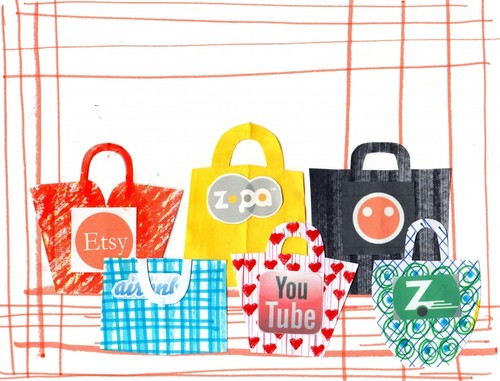
The 3 main problems marketplace exist to solve
Businesses exist to solve problems. This weekend I was at SWSXi where I had luck to meet and watch some of the top entrepreneurs in the world talk about the problems they solved, those that they didn’t get round to solving and are fixated on next. And all the while I kept thinking: how does this apply to our business at PeoplePerHour? And more importantly how does that form a coherent step by step strategy to win? And how are we executing towards it?
Below I summarize my thoughts drawing on some of the insight I gathered at SWSXi and applying our experience at PPH to date.
I believe this applies to any marketplace business. The problems we exist to solve are these 3 and in this sequence.
1. Distribution
Marketplaces exist first and foremost to aggregate and distribute content that’s ready for collaborative consumption (whether that’s a display of your spare room on Airbnb, your grandmas hand knitted sweater on Etsy, your unused car on Zipcar, your spare cash on Zopa or your skills and spare time on PeoplePerHour)
Reaching critical mass – a word you’ll often hear in conversations about marketplaces – is a byproduct of doing this first for a tightly defined unaddressed (or highly differentiated) niche that creates early fanaticism from a small customer group and high word of mouth. The ethos being: it’s better to have 100 people love you that a million ‘sort of like you’. It takes time but at some point it hits a hockey stick curve.
Brian Chesky founder of Airbnb spoke ever so passionately (and loudly !) about how long it took them to get to that hockey stick point, knocking door to door in New York to sign up apartments. Not surprisingly for a property rental business it turned out that focusing on location was key to gaining critical mass.
Chad Hurley founder of Youtube spoke about how focusing on speed and reliability of the video experience was crucial to them, going therefore for short clips uploaded in high volume, versus others in the space before (and after them like Google video) that were trying to substitute for the entire TV experience and failed.
Our experience at PPH is similar. We consciously refocused the business after a hitting the flatter part of an S-curve 12 months ago, on speedy, reliable delivery for small, fixed price jobs which we called ‘Hourlies’, and in particular around creative digital services. We started curating content that meets that those criteria (and will more so with new features we are launching which we never did before. The result: after launching in August within month we started seeing exponential growth again.
In all of these businesses – PPH included – the long tail is the one that eventually scales the business outward but liquidity in a tightly knit niche is the means to that end, and to get that companies must focus on one or two strong differentiators.
Once that fire is lit, distribution is amplified by overlaying user engagement via great community management and encouraging social behavior that mirrors people’s offline experience. Often playing on emotion and vanity. It’s not incidental that YouTube’s strapline is ‘broadcast yourself’. In the past few month at PPH we focused on this a lot, rolling out much deeper integration with Facebook’s open graph and launching features that allow people to improve their online reputation by receiving and giving peer reviews or ‘endorsements’
Equally, we launched ‘Collections’ back in December which are now slowly but surely allowing us to organize the growing content on PPH around themes and allow for better curation of great content. Currently that’s done internally, but the vision of Collections is to open them out to the community (selectively at first) so that all those experts out there, each of whom knows their own domain far better than we ever could, can curate their own niche collections, distribute them and revenue- share with us. They are budding entrepreneurs leveraging our platform to gain distribution.
This perfectly fits in with our mission of ‘allowing people to get their business of the ground’. Fast, easy and reliably.
2. Discovery
The second big problem a marketplace solves is discovery. And the more content and distribution you get the bigger the discovery problem becomes as content gets buried deep down in your listings.
Marketplaces that fail to address this will get disrupted by new entrants who will pick at sections of their marketplace and deliver better discovery. Much like the collaborative consumption space fed off and verticalised sections of Craigslist, it will happen to all of us again if we don’t focus on this problem and keep innovating.
Nature’s regenerative destruction cycle cannot be stopped, it can just be postponed. And its No1 driving force in marketplace businesses is the discovery problem.
At PPH, having amassed some 30,000 Hourlies in a few months our attention has turned to discovery in the past months. Soon we are launching a new UI that will allow our users to filter and sort the content in much improved ways, with more variables, with stronger and constantly fine-tuned search functionality
Equally a next initiative underway is the introduction of a completely new ranking algorithm that enriches and complements the eBay-franchised feedback algorithm by focusing on discovery of quality, reliable and speedy content – the things that drive our content strategy. Feedback alone doesn’t crack it any more if you need to constantly surface gems to the top.
Acronymed CERT which stands for Content, Engagement, Repeat usage and Trust, it collectively – and conveniently – summarizes the four pillars that define a quality experience for both a buyer and a seller on PPH. More specifically: the quality of content you create (both as a buyer and a seller), how quickly and reliably you engage with the other party and abide by the marketplace rules of engagement, how frequently you come back and repeat, and how trusted you are which in itself blends in numerous factors like feedback on your jobs, disputes, cancellations, social connectivity, profile completeness etc. which are all indicators of trust.
Most players in the collaborative consumption space focus heavily on just the feedback-driven Trust element which fails – in itself – to solve the discovery problem and does not tie in with a coherent content strategy. It works, but only in low volumes. Then you get disrupted
3. Creation
It may seem paradoxical that creation is at the bottom of this list. But its not and here’s why: marketplaces like all the ones mentioned initially catch fire by utilizing ‘latent capacity’ in the economy (like the unutilized spare bedroom chucked on Airbnb, grandmas unsold cotton knitting on Etsy, your desire to broadcast yourself on Youtube, your unutilized car on Zipcar, your skills and spare time on PPH).
But that spare capacity is only really scratching the surface. Once these marketplaces utilize that latent capacity (or put in marketing jargon ‘cross the early adopter chasm’) they start to drive a movement of new supply, that’s not idle, from people who weren’t sitting around waiting for this to happen. They start driving reach structural change and disruption as opposed to feeding off the slack.
At this stage what matters is educating those (more mainstream) users on how to create that content and more importantly prepare it for collaborative consumption. They are not as ready for it as the early adopters. This is the most challenging part of any marketplace business. I’m a firm believer that even eBay has just scratched the surface here.
Chad spoke with some despair that they never got to the stage to address this properly before Google bought YouTube and how he’s move to purchase Delicious.com is with a desire to now crack this problem properly. How do you engage people to create and organize the right sort of content? People at Quora are addressing the same problem in a different way. The verdict is still not out there. True entrepreneurs are motivated by solving real and big problems. Chad is one of them.
In our market for example, we quoted recently stats published by the telegraph that 14% of UK’s workforce has some sort of second job. Other stats published by the UK Office of National Statistics and Freelancer Association in the US show that an estimated 1 in 3 people in the working population do some sort of side freelance job. That’s over 60 million people in the UK and US alone and growing in double digits. Collectively all the competitors in our space have – at most – aggregated some 5million of those of which a small % are active. We have barely scratched the surface! We haven’t even began yet!
I’m beyond certain that in the future the majority of people will be working – either regularly or occasionally – online selling their time and skills at will. It’s the true democratization of labour. One of my first ever blog posts in 2007 (yes I date that far back !) spoke about this, when the market was a lot smaller and didn’t show the signs it shows today. Yet the vision remains largely intact.
So the next biggest challenge we will all face is: how do we educate people who are not used to working this way to be successful? How do we set them up for success to help take a very powerful, disruptive concept that resonates with early adopters to the mainstream user base?
The answer will be in online education.
Online education – a burgeoning new mega disruptor.
Online education is a huge new burgeoning market that I’m a big fan of. Companies like Coursera, Udemy, Codecademy, Lynda.com, Khan academy and others are about to disrupt one the largest markets and a pillars stone of society – education.
I watched Al Gore this weekend at SXSWi give a very passionate talk. When he wasn’t talking about global warming and his new book 🙂 (which wasn’t that often admittedly) he spoke about the online education space (disclosing that he is also an investor of Corsera) and how that will drive a paradigm change.
For now the online education is serving primary needs, teaching anything from kids how to do algebra and write english, to teenagers and adults how to code or design. The next wave will be a secondary layer in-between that will serve the purpose of closing the gap between early adopters and the mainstream audience. And stakeholders in the space – PPH included – need to be actively involved. We need to help train and educate people to operate effectively online.
More needs to be done by the government
Incidentally this coming week i’ve been invited by No10 and BIS to a kick off meeting at chaired by Lord Young at No10 putting together an e-commerce cross border task force. The mission of this task force is to help companies succeed online and improve cross border trade, bringing together european leaders in the space to share their insights. This is very refreshing to me, finally the government is looking to do something about it to help businesses start and scale online. Its a good beginning but we have a long way to go. I hold my breath to see what will come of it.

















I loved this. I cringe to admit I didn’t grasp it all, but I gained so much faith in what is being done here and why from all you shared in just one blog post. Thank you.